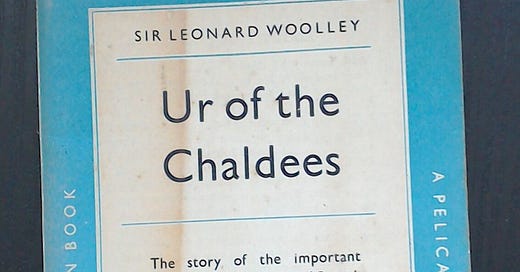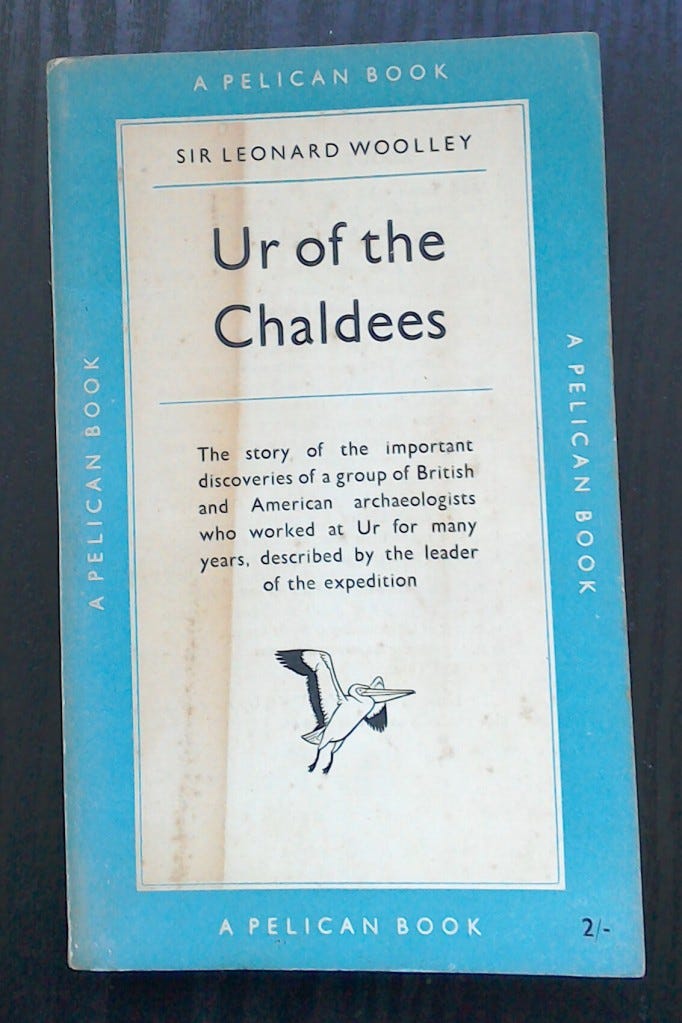A book about archaeology at Ur
I've been trying to use lockdown as a prompt to read the books languishing unread on my bookshelves. It's proving full of delightful surprises, and is also making OneMonkey and I clear out a stupid number of books - more of which in a later post, I'm sure. The latest discovery is this slim volume, Ur of the Chaldees by Sir Leonard Woolley, which I've enjoyed immensely. Woolley was in charge of British Museum excavations in the 1920s at the ancient Sumerian city of Ur in modern Iraq, and this is his account, written in 1929 (though I have the 1952 revised edition, and I think there are modern editions as well).
You may recall I read a book called Footsteps by Bruce Norman last year, about nineteenth and early twentieth century archaeological expeditions and the birth of scientific archaeology. This book on Ur was a nice coda to that, being an expedition right at the end of the time period covered in Footsteps. Woolley describes techniques that made me wince, and I'm sure Professor Mick Aston from Time Team would have thrown up his hands in horror at them, but he is using the most up to date techniques available to him and contrasts them with the plundering seventy years earlier which has damaged some of the remains. I mention Time Team not just because I love the programme, but because Woolley's descriptions of techniques, practicalities and frustrations reminded me of it. It struck me that this swiftly-produced book was the pre-television age version: an insight into the excavations for a popular audience, educating and entertaining in equal measure.
The title is, I believe, a biblical reference which was lost on me, something to do with Abraham. However, I do vaguely recall Nebuchadnezzar and Cyrus from primary school religious studies, and both those kings crop up here. As does Hammurabi, whose eye-for-an-eye code of law I remember learning about in history when I was about twelve. Basically, I know more about ancient Sumerian and Babylonian kings than I thought I did, and you probably do too. Not that it matters, because Woolley's enthusiasm carried me through. The edition I have is 164 pages including the index, which is short enough to be casually and quickly readable. I did get a bit confused about layouts, because there are only twenty-seven black and white photos and a few line drawings in the whole book, but on the whole I got a sense of wonder and discovery as he described unearthing the different layers and artefacts. Amazingly, one of the places they excavated was a museum of antiquities! A site from around 600BCE where objects already at least a thousand years old were gathered as a teaching resource, it seems. A fascinating thought.
Trying to make out details on the small pictures included in this paperback, I wished I could see the objects themselves. He was digging for the British Museum, I realised - they must have pictures somewhere, they're good at that. What they've actually got is a Google street view of the gallery, so you can (if you're better at controlling street view than I am) walk through the gallery as though you were there. And the same goes for the rest of the museum, I think. I did also discover a British Museum blog post, which I haven't explored but I think suggests there's a new online Woolley/Ur resource somewhere. I had a wonderful time spotting objects in the gallery that I recognised either from the photos in the book or from Woolley's descriptions. To have read about the difficulties of identifying or excavating them gave me much more of a connection than if I'd simply looked through the objects without reading about them first.
Possibly I'm just slow on the uptake and everyone else who's missing museums has been tripping through the rooms of their favourites in a virtual way for months. However, I realised that in a similar way I could 'visit' museums I'll never get to in real life. It is vaguely possible my London-based friend will persuade me to the British Museum once all this corona-horror is over, but I'll never go to Cairo or Washington or St Petersburg but chances are their museums have virtual tours too. In the meantime I've also discovered, courtesy of OneMonkey, a reddit channel where people post photos of man-made objects, many of them ancient, from all around the world.
So, Ur of the Chaldees has earnt its continuing place on my bookshelves, next to Footsteps. Unusually for my second-hand books I have no recollection of where it came from or when I acquired it. It's not ex-library, I can't imagine anyone giving me it as a present, and I can see no evidence of a rubbed-out price from a charity shop. I have no idea what possessed me to pick it up in the first place, or why I then didn't read it for years. However, I dare say I've appreciated it more after Footsteps than I might have done if I'd read it a couple of years ago so all in all, I'm glad I put it off.
If I’ve helped you discover some wonders you can always buy me a cuppa…





